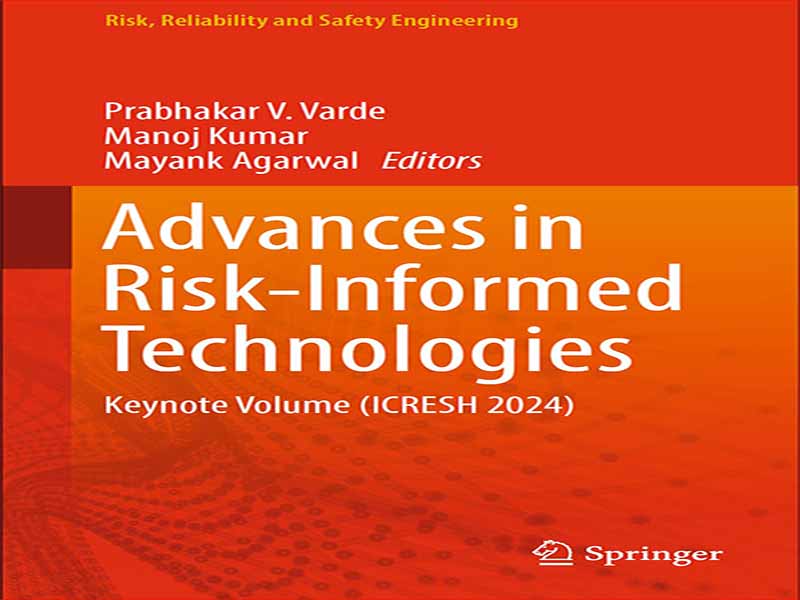- عنوان کتاب: Advances in Risk-Informed Technologies
- نویسنده: Prabhakar V. Varde
- حوزه: فناوریهای نوظهور
- سال انتشار: 2024
- تعداد صفحه: 173زیان اصلی: انگلیسی
- نوع فایل: pdf
- حجم فایل: 4.60 مگابایت
در این نظم جهانی در حال تحول که جدای از اقتصاد و پایداری به عنوان دو شاخص اصلی، عوامل مهمی مانند “ریسک زدایی” وجود دارد – که اجزای تصادفی و با انگیزه یا مورد نظر ریسک (ایمنی و امنیت) را پوشش می دهد. قابلیت اطمینان که بخشی جدایی ناپذیر از معیارهای قابلیت اطمینان را تشکیل می دهند. سیستمهای مهندسی کنونی که ریشه در تکامل فناوری دارند، اساساً توسط قوانین یا مشخصات، بهترین روشها، یادگیری عملی، تجربه، و سیستمهای بازبینی شده و اجرایی اداره میشوند. در اینجا، دامنه تفسیر، گاه به تصمیم گیری محدود می شود. ما شاهد پیشرفت خارقالعادهای در علم و فناوری هستیم که در فنآوریهای پیشرفته نیز منعکس میشود که نه تنها اهداف ایمنی و قابلیت اطمینان را پشتیبانی میکنند، بلکه به طور مؤثری افزایش میدهند. پیشرفت در فناوری ایمنی و قابلیت اطمینان در سیستمهای حیاتی ایمنی، به عنوان مثال، ساختاری، فرآیندی، فضایی، هستهای، حملونقل آبی، و حملونقل ریلی و جادهای گواهی یا ادای احترام به موفقیتهای پیشرفته در علم و فناوری است. با این حال، اگر به تاریخچه حوادث و چالش های اجتماعی نگاه کنیم، باز هم می بینیم که تلاش های بیشتری لازم است. یکی از مشاهدات عمده این بوده است که عامل انسانی یکی از عوامل مؤثر در تصادفات و ناآرامیها است، و هنوز هم تعجب میکنیم که «حتی در حال حاضر کارهای زیادی باید انجام شود». اگر اکوسیستم بینالمللی کنونی شاخصی باشد، پس بدیهی است که برای پیشرفت و خوشبختی واقعی، ما به یک سیستم ارزشی عمیق نیاز داریم که در آن «آگاهی یا به عبارت دقیقتر نظام ارزشی مبتنی بر وجدان، نیاز روز باشد». . البته، معیارهای “کیفیت” تا حد زیادی موثر است که عملکرد مطلوب و جنبه های مربوط به قابلیت اطمینان را برای سیستم های مهندسی و اجتماعی به عنوان نقطه شروع تضمین می کند. در اینجا ویژگیهای ریسک و قابلیت اطمینان به وجود میآیند که پتانسیلی برای تضمین عملکرد کلی محصول، سیستم و خدمات با استفاده از اهداف و معیارهای کمی، تا حد زیادی، به صورت دائمی دارند. با این حال، چالش این است که علم و فناوری ریسک و قابلیت اطمینان هنوز به سطح بالاتری از ملاحظات دست پیدا نکرده است، به عنوان مثال، تقاضا برای قابلیت بالاتر از نظر ثبت شکست پویا، علت مشترک، عامل انسانی و داده ها و مدل هایی با سطح قابل قبولی از عدم قطعیت، برای مقبولیت بهتر، و بیشتر بخشی از مهندسی مبتنی بر ریسک و بیشتر می شود. در اینجا، خطر از دست دادن دسترسی و قابلیت اطمینان را نیز پوشش میدهد که ممکن است منجر به از دست دادن تولید و به خطر افتادن خدمات شود که در نهایت و تأثیرات نامطلوبی بر سود کسبوکار دارد. وضعیت هنر در PRA به طور کلی به اندازه کافی بالغ در نظر گرفته می شود که بخشی از ارزیابی مبتنی بر ریسک را تشکیل می دهد. دلیل آن این است که PRA یک مدل یکپارچه، ساختاریافته و کمی را با پیشبینی مشخص کردن عدم قطعیت ارائه میکند که برای هر بازبینی و ارزیابی مورد نیاز است. در اینجا، ارزیابی ریسک احتمالی (PRA) بستر مورد نیاز را برای تکمیل یا تکمیل روشهای قطعی موجود به عنوان بخشی از یک رویکرد آگاهانه از ریسک یا به عنوان یک رویکرد جایگزین یا مستقل برای نه تنها ارزیابی ریسک، بلکه برای توسعه ریسک فراهم میکند. برنامههای کاربردی مبتنی بر نیاز به شناسایی و اولویتبندی، بهعنوان مثال، بازرسی ضمن خدمت مبتنی بر ریسک، فعالیتهای عموماً یکباره – مدیریت پیری و مدیریت تعمیر و نگهداری معمول، شناسایی اهمیت ایمنی برای حمایت از اولویتبندی مدیریت بازبینی نظارتی، و غیره. افزایش علاقه به استفاده یا اتخاذ رویکرد مبتنی بر ریسک یا مبتنی بر ریسک و راهحلهای مؤثر که در ادبیات باز قابل مشاهده است، نشان میدهد که این ابزارها و روشها به بخشی جدایی ناپذیر از طراحی، عملیات و مقررات تبدیل خواهند شد. در شرایط فعلی، پوشش نقره ای در زمینه خطر زدایی از سیستم ها، ساختارها و اجزای ما ظاهر می شود. رشد خارقالعاده فناوریهای پیشرفته از جمله دیجیتال، محاسبات پیچیده، هوش مصنوعی و یادگیری ماشینی همراه با در دسترس بودن دادهها و تجربه، ایجاد یک اکوسیستم برای تحقیق و توسعه پیشرفته، در جهت رسیدگی به چالشهای مهندسی در زمان واقعی است. این واقعاً یک توسعه امیدوارکننده برای تثبیت بیشتر اثربخشی رویکرد مبتنی بر ریسک و توسعه بیشتر یا بهبود فناوری مبتنی بر ریسک برای سیستمهای پیچیده مهندسی سیستم است. هدف پشتیبانی از مراحل مختلف توسعه از مفهوم سازی، طراحی، راه اندازی، بهره برداری، تنظیم و در نهایت دفع به عنوان بخشی از ردیابی پایداری است. بحث بالا زمینه ای را برای شناسایی عنوان و موضوع این کتاب با عنوان پیشرفت در رویکرد مبتنی بر ریسک برای سیستم های مهندسی پیچیده-نقش تحول آفرین فن آوری های در حال تکامل فراهم می کند.
In this evolving global world-order where apart from economics and sustainability as the two major indicators, there are overriding factors, like ‘de-risking’—that covers random as well motivated or intended components of risk (safety and security)— and ‘reliability’ that form an integral part of dependability metrics. The current engineering systems, having their roots in technological evolution, are essentially governed by rules or specifications, best-practices, hands-on learning, experience, and peer-reviewed and enforcement systems. Here, the scope for interpretation, at times, is limited towards arriving at decisions.
We witness phenomenal progress in science and technology that is also reflected in advanced technologies that not only support but effectively enhance safety and reliability objectives. The advancement in safety and reliability technology in safety-critical systems, viz., structural, process, space, nuclear, water transport, and rail and road transport are a testimony or tribute to the success of state of the art in science and technology. However, if we look at the history of accidents and societal challenges, we still see that further efforts are required. One of the major observations has been that the human factor is one of the major contributing factors to accidents and unrest, and one still wonders—‘a lot has to be done even now’.
If the present international eco-system is any indicator, then it is evident that for true progress and happiness, we need a profound value-based system where ‘consciousness or to be more precise conscience-driven value system is the need of the hour’. Of course, ‘quality’ metrics is effective to a great extent ensuring desired performance and dependability-related aspects for engineering and social systems as a starting point. Here come risk and reliability attributes that have potential to ensure product, system and service overall performance employing quantitative goals and criteria, to a large extent, in perpetuality.
However, the challenge is the science and technology of risk and reliability is yet to achieve the higher level of considerations, e.g., demands for higher capability in terms of capturing dynamic, common cause failure, human factor and data and models with an acceptable level of uncertainty, for improved acceptability, and further become part of risk-informed and further risk-based engineering. Here, the risk also covers loss of availability and reliability that might lead to loss of production and compromised services that eventually and adversely impact the business bottom-line.
The state of the art in PRA is generally considered as matured enough to form a part of risk-informed evaluation. The reason is, PRA provides an integrated, struc-tured and quantified model with provision to characterize uncertainty, documented required for any review and evaluation. Here, the Probabilistic Risk Assessment (PRA) provides a needed platform to either complement or supplement the existing deterministic methods as part of a risk-informed approach or as an alternate or standalone approach for not only risk assessment but also for the development of risk-based applications requiring identification and prioritization, e.g., risk-based in-service inspection, generally one-time activities—ageing management and routine maintenance management, safety significance identification to support prioritization of regulatory review management, etc. The increasing interest in the use or adoption of risk-based or risk-informed approach and effective solutions that can be seen in the open literature shows that these tools and methods will become an integral part of design, operation and regulation.
In the present context, there appears a silver lining in the context of de-risking our systems, structures and components. The phenomenal growth of advanced tech-nologies including digital, complex computing, artificial intelligence & machine learning coupled with availability of data and experience is creating an eco-system for advanced research and development, towards addressing real-time engineering challenges. This is truly a promising development for further consolidating the effectiveness of the risk-informed approach and further development or improving risk-based technology as applicable to complex system engineering systems. The objective is to support various stages of development right from conceptualization, design, commissioning, operation, regulation and finally disposal as part of tracking sustainability.
The above discussion provides the background for identifying the title and theme of this book entitleds Advances in Risk-Based Approach for Complex Engi-neering Systems—Transformative Role of Evolving Technologies.
این کتاب را میتوانید بصورت رایگان از لینک زیر دانلود نمایید.
Download: Advances in Risk-Informed Technologies



































نظرات کاربران